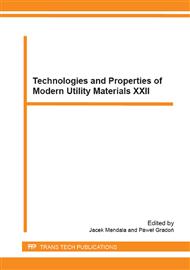p.53
p.59
p.65
p.69
p.75
p.79
p.87
p.91
p.95
Influence of the Thermo-Mechanical Treatment on the Properties and Microstructure of High Manganese Austenitic-Ferritic Steel
Abstract:
New generation high-strength austenitic and austenitic-ferritic manganese steels represent a valid potential in applications for components in the automotive and railway industry due to the perfect combination of high mechanical properties and formability. Applying this new steels with their combination of properties allows for reduce the weight of vehicles by the use reduced cross-section components and thus to reduce fuel consumption. The development and implementation of industrial production and the use as construction materials such interesting and promising steel is conditioned to improve their casting properties and susceptibility to deformation during thermomechanical processes conditions. In this work, applied an new high manganese austenitic-ferritic steel for analysis the influence of the cooling medium in thermomechanical processes on the mechanical properties and structure of researched steel. The steel was hot rolled with finish temperature 900°C and next cooled with different conditions. Change the cooling conditions effect on the changes in the microstructure of the tested steel, observed grain refinement of austenite and ferrite morphology change. Also are changing the mechanical characteristics of the tested steel.
Info:
Periodical:
Pages:
75-78
Citation:
Online since:
January 2015
Authors:
Price:
Сopyright:
© 2015 Trans Tech Publications Ltd. All Rights Reserved
Share:
Citation:


